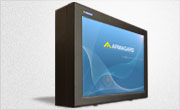Different Screens for Digital Signage
Posted by: Richard Williams | Posted on: | 1 Comments
There was a time when television came in only one type—the CRT (Cathode Ray Tube). Few of these bulky TVs ever made it out of the home, but now, with the rise of the flat screen television televisions are a common sight in our shopping malls, airports and even along our high streets in the guise of digital signage.
And no longer are we restrained to one type of television as modern flat panel displays come in several variants:
The Flavours of Flat Screen
Modern flat screens come in two major varieties, the plasma and the LCD (liquid crystal display). While at first sight, both may look the same there are major differences. Plasma screens do not require backlighting, the energised plasma providing the contrast and brightness of the screen. Generally, plasmas require more power than LCDs, but LCDs also some sort of lighting system to make the screen visible. Traditionally, cold cathode fluorescent lamps (CCFLs) provide the backlight of an LCD, but the downsides to this is the amount of energy they require.
Recently, LEDs (light emitting diodes) are replacing CCFLs, which use far less power and produces less heat helping to extend the life of the screen. This has great advantages for digital signage; reducing running costs and helping to make the initial investment in the screen last longer.
Outdoor Digital Signage
While backlit LCDs are becoming common in the world of indoor digital displays, when it comes to outdoor digital signage—brightness becomes imperative. The difficulty with using a screen outdoors (besides having to protect screens from weather, temperature and attention of vandals) is something many of us who have tried to watch television on a bright afternoon may have faced—screen glare and fade out.
The sun causes both of these problems, reflecting off the surface of the screen causing glare and making the display unreadable, or washing out and fading the screen image as the brightness of the sun supersedes the screens maximum contrast level.
High brightness screens are commonly backlit LCDs that generate up to three times higher brightness than standard devices. A standard LCD normally puts out about 500 nits (unit of luminance) while a high brightness display will produce 1200-1800 nits.
Waterproof Screens
Another fairly new variant of the flat screen TV is the waterproof outdoor display. These devices, however are highly expensive and when you compare the cost of a normal commercial grade display—even high brightness—and the combined price of protecting it in an outdoor LCD enclosure, the excessive price of these outdoor displays can be difficult to justify.
Post shortlink:
Popular Products
LCD Enclosure
Need armor for your LCD/LED screen(s)? Outdoors or inside the versatile LCD enclosure protects against thieves, vandals & the weather. Installation idea: NFL stadiums.
Outdoor Digital Signage
Exclusive 46” outdoor screen protection. Dubbed the ‘Totem’, due to its distinct design, it repels damage threats, but attracts audiences. Installation idea: Drive-thru restaurants.
Portrait Flat Panel Enclosure
Safeguard your eye-level advertising display screen(s), indoors or outdoors. Completely customizable, add exciting features like touch screen technology. Installation idea: Restaurant frontages.
Indoor Digital Signage
Popular purchase for retail outlets! Great for ‘point of sale’ persuasion, boost your brand with static & motion advertising from a single unit! Installation idea: Mall of America.




